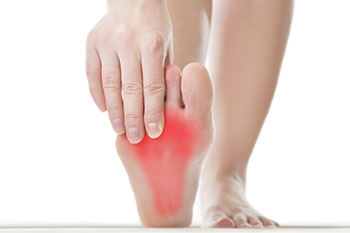Plantar Fasciitis

Plantar fasciitis affects the plantar regions of the foot, namely the heel, arch, and mid-foot. When too much stress is put on the plantar fascia, or the connective tissue that stretches from the heel to the ball of your foot, inflammation, over-tightening, and tearing may arise. This can cause foot pain. Because of plantar fasciitis, you may experience tearing with the first steps you take in the morning each day.
A certain trigger that may cause stress to the plantar fascia includes poor arch support, which is brought upon by frequently walking barefoot or wearing shoes with improper arch support. Other causes include obesity or a sudden increase in weight, increased physical activity, weak foot and ankle muscles, tight calf muscles, and arthritis.
If you’re feeling pain after sitting, walking, or standing for a long period of time, as well as when you first step out of bed or climb stairs, you may be showing signs of plantar fasciitis. To know what’s causing you pain for sure and to avoid the condition worsening over time, it’s best to meet with a podiatrist as soon as possible. They will conduct an examination and x-ray of your foot in order to make a proper diagnosis and advise a treatment plan.
Our podiatrists have extensive experience treating plantar fasciitis, as it is the most common form of heel pain that we treat in our office. We have achieved great outcomes with two treatments in particular: Tenex and Topaz.
In the Tenex procedure, ultrasound is precisely administered through a hollow needle at the site of pain. Diseased plantar fascia tissue is broken up-leaving healthy tissue undisturbed-and the body’s natural healing process is stimulated. No general anesthesia is needed, and the incision where the needle was inserted is so small, usually a bandage is all that is needed. Recovery time is accelerated with this procedure (typically 4-6 weeks), and it usually only requires one treatment. In the minimally invasive Topaz procedure, the podiatrist uses the Topaz wand (similar to a sewing needle) to poke small holes in a grid pattern on the bottom of the foot. Each time the needle is inserted, a split-second pulse of radio-frequency energy enters the plantar fascia and dissolves inflamed scar tissue. This causes blood flow to return and healthy tissue to develop.
Topaz is a quick outpatient procedure where the patient is given a local anesthetic to sleep, but breathes on their own. Depending on the various factors, some patients may be able to walk out within hours after the procedure wearing a post-op boot. Recovery usually occurs within weeks.
